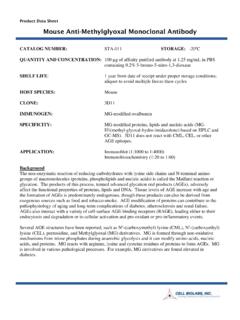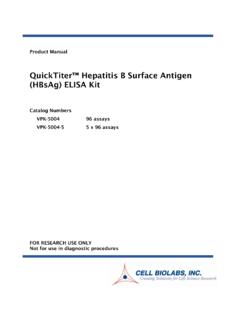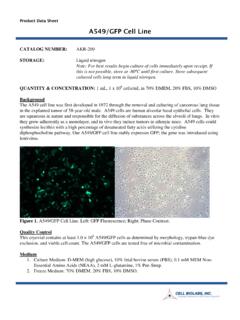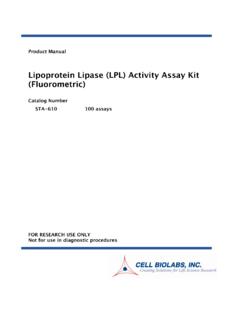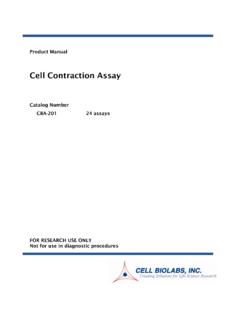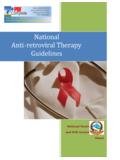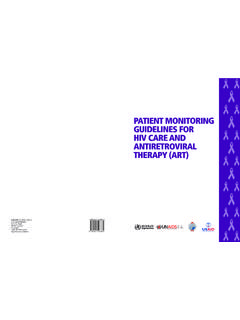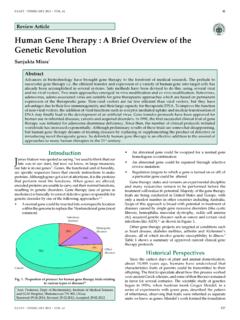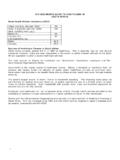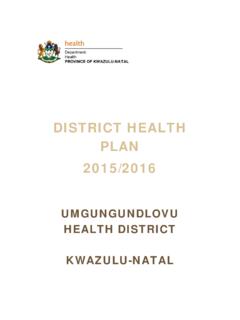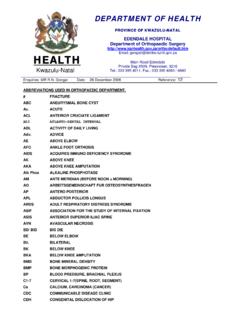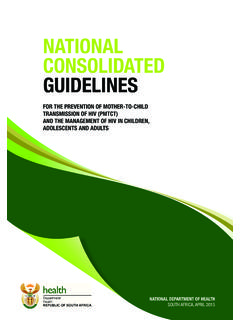Transcription of Platinum- GP Retroviral Packaging Cell Line, …
1 Product Data Sheet platinum - GP Retroviral Packaging Cell line , pantropic CATALOG NUMBER: RV-103. STORAGE: Liquid nitrogen Note: For best results begin culture of cells immediately upon receipt. If this is not possible, store at -80 C until first culture. Store subsequent cultured cells long term in liquid nitrogen. QUANTITY & CONCENTRATION: mL, >3 X 106cells/mL in DMEM, 20% FCS and 10% DMSO. Background Retroviruses are efficient tools for delivering heritable genes into the genome of dividing cells . However, conventional NIH-3T3 based Retroviral Packaging cell lines have limited stability and produce low viral yields, mainly due to poor expression level of the Retroviral structure proteins (gag, pol, env) in the Packaging cells . The Platinum- GP (Plat-GP) Cell line , a potent retrovirus Packaging cell line based on the 293T cell line , was generated using novel Packaging constructs with an EF1 promoter to ensure longer stability and high-yield Retroviral structure protein expression (gag and pol).
2 Plat-GP cells can be kept in good condition in for at least 4 months in the presence of drug selection, and can produce retroviruses with an average titer of 1 x 107 infectious units/mL by transient transfection. In addition, replication competent retroviruses (RCR) are virtually nonexistent because only coding sequences of viral structural genes are used, avoiding any unnecessary Retroviral sequences. The Plat-GP cell line allows you to select the envelop according to the tropism needed. The viral env gene, such as VSV-G, must be cotransfected with the Retroviral expression vector. The Plat-GP cell line is designed for rapid, transient production of high-titer retrovirus. Figure 1. Jurkat cells were infected with GFP retrovirus supernatant produced in Plat-GP cells after transfection. Medium 1. Culture Medium: DMEM, 10% fetal calf serum (FCS), 10 g/mL blasticidin, penicillin and streptomycin 2.
3 Freeze Medium: 70% DMEM, 20% FBS, 10% DMSO. Methods I. Establishing Plat-GP Cultures from Frozen cells 1. After quickly thawing the cells in a 37 C water bath, immediately transfer the thawed cell suspension into a 15 mL tube containing 10 mL of culture medium. 2. Centrifuge the tube for 5 min at 1300 to 1500 rpm. 3. Discard the supernatant and break the cell pellet by finger tapping. 4. Add a few drops of culture medium with gentle shaking and finger tap the tube a few times. 5. Add 2 mL of culture medium to the tube and gently pipet the cell suspension up and down twice. 6. Transfer the cell suspension to a 10 cm culture dish (Falcon #3003 works well) containing 8 mL. of culture medium. 7. Swirl the culture plate well to mix the cells , then incubate the cells for three days before expansion. Important Notes: Don't change the culture medium during the first three days.
4 It is normal to see some cells floating after the first 24 hours. Don't culture cells to complete confluency. Split cells 4X to 6X every two to three days when the culture reaches 70-90% confluency. II. Splitting the cells Note: Avoid forming bubbles as much as possible during this procedure. 1. Wash cells once with PBS. 2. Add 4 mL of mM EDTA solution to a 10 cm dish and incubate at 37 C for 3-5. min. 3. Remove the cells from the dish surface by tapping the rim of the culture dish. 4. Transfer 10 mL of the culture medium to a 50 mL tube. 5. Using the same pipette with some residual culture medium, wash the dish surface gently three times in 4 mL of theTrypsin/EDTA solution. 6. Gently pipette the cell suspension up and down 7 times and transfer the cell suspension into the 50. mL tube containing 10 mL medium from step 4. 7. Centrifuge the cells for 5 min at 1300-1500 rpm.
5 8. Discard the supernatant and break the cell pellet by finger tapping. 9. Add a few drops of culture medium with gentle shaking and finger tap the tube a few times. 10. Add 5 mL of culture medium and gently pipet the cell suspension up and down twice. 11. Add 15 mL of culture medium, then count and seed the cells . Typically 107 cells can be harvested from one 10 cm culture dish. Transfection 1. Seed 2 x 106 cells in a 60 mm culture dish without antibiotics including blasticidin one day before transfection. 2. After 16 to 24 hours, start transfection when the culture becomes 70-80% confluent. Note: We suggest transfecting cells with FuGENE Transfection Reagent (Roche Applied Science) or Lipofectamine Plus (Invitrogen). For example, 3 g DNA is mixed with 9 L. FuGENE Transfection Reagent according to the manufacturer's recommendation. The mixed DNA- FuGENE complex is added by dropwise into the culture media.
6 3. Harvest Retroviral supernatant 48 hours after transfection. References 1. Morita, S., Kojim, T., and Kitamura, T. (2000) Gene Therapy 7: 1063-1066. Recent Product Citations 1. Wakao, J. et al. (2017). Efficient direct conversion of human fibroblasts into myogenic lineage induced by co-transduction with MYCL and MYOD1. Biochem. Biophys. Res. Commun. 488(2):368-373. 2. Kim, N. et al. (2016). Immobilized pH in culture reveals an optimal condition for somatic cell reprogramming and differentiation of pluripotent stem cells . Reprod. Med. Biol. 3. Kanda, S. et al. (2016). Autonomous translational pausing is required for XBP1u mRNA. recruitment to the ER via the SRP pathway. PNAS 113:E5886-E5895. 4. Yang, W. S. et al. (2016). Peroxidation of polyunsaturated fatty acids by lipoxygenases drives ferroptosis. Proc Natl Acad Sci U S A. 5. Niikura, Y. et al. (2016). CENP-A ubiquitylation is inherited through dimerization between cell divisions.
7 Cell Rep. 6. Prentice-Mott, H. V. et al. (2016). Directional memory arises from long-lived cytoskeletal asymmetries in polarized chemotactic cells . Proc Natl Acad Sci U S A. 113:1267-72. 7. Araki, M. et al. (2016). Activation of the thrombopoietin receptor by mutant calreticulin in CALR- mutant myeloproliferative neoplasms. Blood. 8. Gallant, J. N. et al. (2015). EGFR kinase domain duplication (EGFR-KDD) is a novel oncogenic driver in lung cancer that is clinically responsive to afatinib. Cancer Discov. 5:1155-1163. 9. Mizoshiri, N. et al. (2015). Transduction of Oct6 or Oct9 gene concomitant with Myc family gene induced osteoblast-like phenotypic conversion in normal human fibroblasts. Biochem Biophys Res Commun. doi: 10. Kuroda, M. et al. (2015). Interaction between TIM-1 and NPC1 is important for cellular entry of ebola virus. J Virol. 89:6481-6493. 11. Yamamoto, K. et al.
8 (2015). Direct conversion of human fibroblasts into functional osteoblasts by defined factors. Proc Natl Acad Sci U S A. 12. Gallaher, Z. R. et al. (2014). Neural proliferation in the dorsal root ganglia of the adult rat following capsaicin induced neuronal death. J Comp Neurol. 522:3295-3307. 13. Handorf, A. et al. (2014). Endogenously Produced Indian Hedgehog Regulates TGF -Driven Chondrogenesis of Human Bone Marrow Stromal/Stem cells . Stem cells Dev. 14. Kageyama-Yahara, N. et al. (2014). Gli regulates MUC5AC transcription in human gastrointestinal cells . 9:e106106. 15. Kuroda, M. et al. (2014). A polymorphism of the TIM-1 IgV domain: Implications for the susceptibility to filovirus infection. Biochem Biophys Res Commun. 455:223-228. 16. Watanabe, R. et al. (2014). Autophagy plays a protective role as an anti oxidant system in human T cells and represents a novel strategy for induction of T cell apoptosis.
9 Eur J Immunol. 44:2508- 2520. 17. Bai, H. et al. (2014). Establishment and characterization of immortalized bovine endometrial epithelial cells . Anim Sci J. 85:799-804. 18. Fujiwara, T. et al. (2014). Identification of acquired mutations by whole-genome sequencing in GATA-2 deficiency evolving into myelodysplasia and acute leukemia. Ann Hematol. 93:1515- 1522. 19. Mott, et al. (2013). Biased migration of confined neutrophil-like cells in asymmetric hydraulic environments. PNAS. 110:21006-21011. 20. Park, et al. (2013). An isoform of C/EBP , LIP, regulates expression of the chemokine receptor CXCR4 and modulates breast cancer cell migration. J. Biol. Chem. 288:28656-28667. 21. Togami, H. et al. (2013).Comprehensive in vitro analysis of simian retrovirus type 4 susceptibility to antiretroviral agents. J. Virol. 87:4322-4329. Warranty These products are warranted to perform as described in their labeling and in Cell Biolabs literature when used in accordance with their instructions.
10 THERE ARE NO WARRANTIES THAT EXTEND BEYOND THIS EXPRESSED WARRANTY. AND CELL BIOLABS DISCLAIMS ANY IMPLIED WARRANTY OF MERCHANTABILITY OR WARRANTY OF. FITNESS FOR PARTICULAR PURPOSE. CELL BIOLABS's sole obligation and purchaser's exclusive remedy for breach of this warranty shall be, at the option of CELL BIOLABS, to repair or replace the products. In no event shall CELL BIOLABS. be liable for any proximate, incidental or consequential damages in connection with the products. License Information This licensed product is intended for ACADEMIC, GOVERNMENT AND NON-PROFIT RESEARCH. USE ONLY; not for use in diagnostic or therapeutic procedures. The product may not be transferred, sold, or otherwise provided to another laboratory except by an authorized distributor of Cell Biolabs, Inc. Use of this product by Biotechnology and Pharmaceutical companies requires a license for all fields of use including research.
